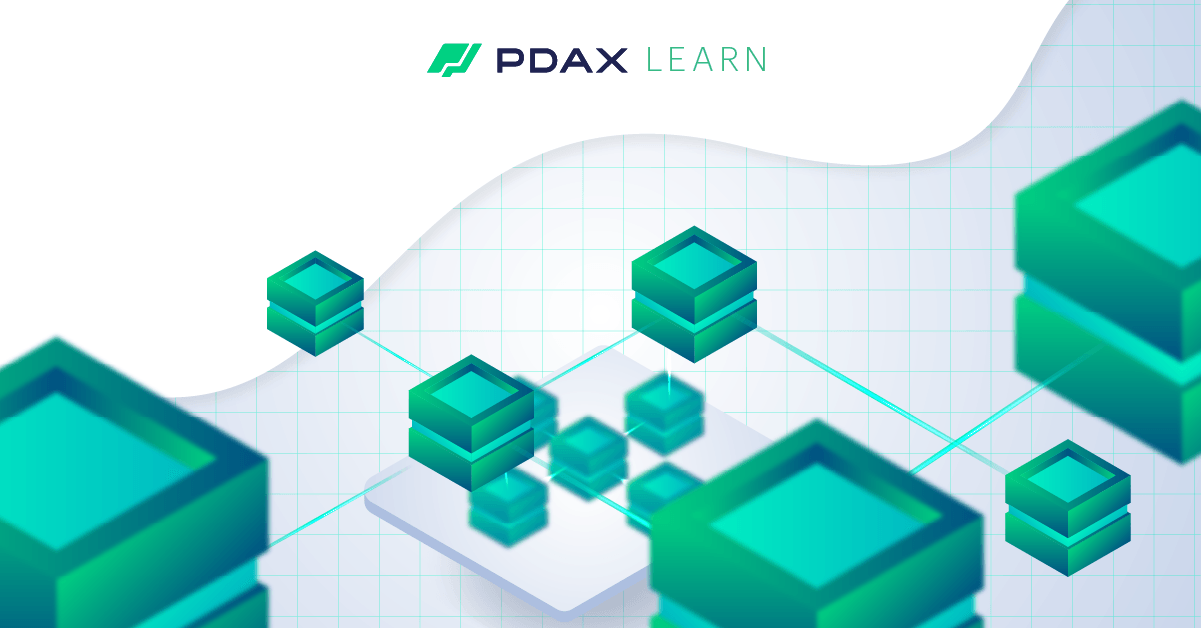What is a blockchain?
PDAX
June 13, 2022
4 min read
TL;DR
A blockchain is a decentralized ledger that is able to store data across multiple points in a network, as opposed to having one central storage unit. This design ensures that records stored in a blockchain cannot be deleted or edited without the “consent” of all the network participants. Data is stored in “blocks” and are cryptographically linked with one another to make a highly secure chain.
What is a blockchain?
A blockchain is a digital ledger which can store records simultaneously across a computer network and was designed as a highly innovative solution to problems surrounding data storage and security. Case in point: how many times have you had a USB flash drive or an external hard drive get broken or corrupted so that all of the data inside it is lost forever?
That’s also the kind of risk that hounds not only ordinary people but also businesses and even big companies that store large amounts of data. Let’s take an example of one large data-dependent company, say Google. If the servers at Google’s data centers suddenly fail for some reason, then this could potentially compromise a lot of operations that depend on their technology for storing, accessing and sharing data.
This is the kind of disaster that blockchain technology avoids–and it does this simply by storing data across numerous computers in a global peer-to-peer network, instead of storing it in only one central location.
This level of reliability and security is what makes the blockchain an ideal ledger for storing financial data, such as for cryptocurrency transactions.
Why is it called a blockchain?
A blockchain is sometimes referred to as “distributed ledger technology”. Similar to the ledgers that accountants use to record and monitor transactions, a blockchain functions in the same way, but with some really serious security features.
The blockchain stores data into segments called “blocks”. Think of blocks as individual pages in a ledger book, and once they’re full of data, newer blocks are then created that tie it together with the previous block. This process repeats itself over and over, creating a “chain of blocks” that constantly grows as more and more data is processed by the network.
However, unlike pages in a physical ledger (which can be written over, ripped out, or replaced) the blocks in a blockchain are cryptographically linked with one another in such a way that once a block is added, the data inside it can no longer be changed. Attempting to edit or delete anything in a block will automatically invalidate all the other blocks that were added after it.
The blockchain as a decentralized ledger
Another thing about blockchain technology is that it’s a ‘decentralized” ledger. This means that no single entity, authority, or organization can lay claim over the entire network.
Control over the blockchain is instead distributed across terminals across the globe called “nodes”. These nodes are dedicated hardware devices that run specialized software responsible for the maintenance of the blockchain.
For large blockchain networks, the number of nodes can range in the tens or hundreds of thousands. Each of these nodes has its own copy of the ledger, which they constantly update with each other through a voting process called a consensus protocol. This system ensures that only one version of the ledger exists at any given time, and makes it nearly impossible for anyone to “hack” since doing so would require taking over the majority of the network to take over the majority vote.
If this is still confusing, think of the blockchain like a Google document. Imagine a group of students working on a paper together and all of their members contribute and share in the workload. Any additions an individual makes to the document can be seen and observed in real-time by the other members. So, if one member starts messing up their part, other members can quickly police that individual to make sure that the paper’s integrity is not compromised.
All in all, blockchain technology is incredibly flexible in the various ways that it can be applied to improve efficiency and security over any network that is used to handle data. From processing payments, keeping digital records, anonymous voting, supply chain and logistics management– the possibilities are only limited by the imagination, and the tech industry is constantly discovering newer ways of applying this emerging technology into our everyday lives.
Ready to start with crypto?
Start your trading journey with PDAX.
DISCLAIMER: The statements in this article do not constitute financial advice. PDAX does not guarantee the technical and financial integrity of the digital asset and its ecosystem. Any and all trading involving the digital asset is subject to the user’s risk and discretion and must be done after adequate and in-depth research and analysis.
About PDAX
PDAX is a BSP-licensed exchange where you can trade Bitcoin, Ethereum, and other cryptocurrencies directly using PHP!
Featured Posts
You might also like
3 Reasons to Invest in Retail Treasury Bonds
PDAX
February 15, 2024
What is digital collectible art?
PDAX
June 26, 2023
How does a digital collectible work?
PDAX
June 22, 2023
How to avoid becoming a money mule
PDAX
June 13, 2023
